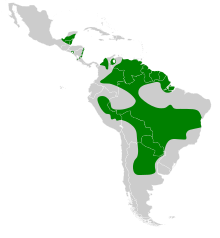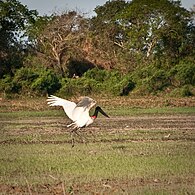Jabiru
| Jabiru | |
|---|---|
| In the Pantanal, Brazil | |
| Scientific classification | |
| Domain: | Eukaryota |
| Kingdom: | Animalia |
| Phylum: | Chordata |
| Class: | Aves |
| Order: | Ciconiiformes |
| Family: | Ciconiidae |
| Genus: | Jabiru Hellmayr, 1906 |
| Species: | J. mycteria
|
| Binomial name | |
| Jabiru mycteria (
Lichtenstein, MHC , 1819) | |

| |
The jabiru (/ˌdʒæbɪˈruː/ or /ˈdʒæbɪruː/; Jabiru mycteria) is a large stork found in the Americas from Mexico to Argentina, except west of the Andes. It sometimes wanders into the United States, usually in Texas, but has also been reported in Mississippi, Oklahoma and Louisiana.[3][4] It is most common in the Pantanal region of Brazil and the Eastern Chaco region of Paraguay. It is the only member of the genus Jabiru. The name comes from the Tupi–Guaraní language and means "swollen neck".[5]
Taxonomy
The proposed Late Pleistocene fossil stork genus Prociconia from Brazil might actually belong in Jabiru. A fossil species of jabiru was found in the early Pliocene Codore Formation near Urumaco, Venezuela, and named Jabiru codorensis.[7]
In Portuguese, the bird is called tuiuiu, tuim-de-papo-vermelho ("red-necked tuim", in
Description
The jabiru is the tallest flying bird found in South America and Central America, often standing nearly the same height as the flightless and thus much heavier greater rhea. For the continent, it also has the second largest wingspan, after the Andean condor (that is, excluding the great albatross occasionally found off the coast of southern South America).[6] The adult jabiru is 120–140 cm (47–55 in) long, 2.3–2.8 m (7.5–9.2 ft) across the wings, and can weigh 4.3–9 kg (9.5–19.8 lb).[6] Sexual dimorphism is high, possibly the highest of any stork, with males being about 25% larger than females. Males weigh an average of 6.89 kg (15.2 lb) whereas females weigh an average of 5.22 kg (11.5 lb).[8] Large males may stand as tall as 1.53 m (5.0 ft). The beak, which measures 25–35 cm (9.8–13.8 in), is black and broad, slightly upturned, ending in a sharp point. Among other standard measurements, the tail measures 20–25 cm (7.9–9.8 in), the tarsus measures 28.5–39 cm (11.2–15.4 in) long and the wing chord measures 58.5–73 cm (23.0–28.7 in).[6] The plumage is mostly white, but the head and upper neck are featherless and black, with a featherless red stretchable patch at the base.[9] The sexes are similar in appearance but the male is larger, which can be noticeable when the sexes are together. While it can give the impression of being an ungainly bird on the ground, the jabiru is a powerful and graceful flier.
Life history
Food and feeding habits
The jabiru lives in large groups near rivers and ponds and eats prodigious quantities of frogs, fish, snakes, snails, insects, and other invertebrates.[10] It will even eat fresh carrion and dead fish, such as those that die during dry spells, and thus help maintain the quality of isolated bodies of water. They feed in flocks and usually forage by wading in shallow water. Jabirus detect prey more through tactile sensation than vision. They feed by holding their open bill at a 45-degree angle to the water. When prey is contacted, the storks close their bill, draw it out of the water, and throw their head back to swallow.[11] Fish around 8 to 20 cm (3.1 to 7.9 in) are typically taken, though larger fish weighing up to at least 500 g (1.1 lb) and eels up to 80 cm (31 in) can be taken.[12][13] It is an opportunistic feeder. In one instance, when house mice experienced a population explosion in an agricultural area, several hundred jabirus could be seen in each field feeding on the rodents (unusual for a bird that's rarely seen in large numbers anywhere).[6] On rare occasions, jabirus have been seen attempting to kleptoparasitize the two smaller storks it co-exists with, the wood and maguari storks.[6]
Breeding

Jabirus are solitary nesters, building massive nest platforms that are used repeatedly in successive seasons. Unlike many other storks, these species are often seen in pairs in the nonbreeding season, suggesting a lifelong pair bond.[14] The nest of sticks is built by both parents around August–September (in the Southern Hemisphere) on tall trees, and enlarged at each succeeding season, growing to several meters in diameter. Nests are often deeper than they are wide; they can be up to 1 m (3.3 ft) wide and 1.8 m (5.9 ft) deep.[11] Half a dozen nests may be built in close proximity, sometimes among nests of herons and other birds. The parents take turns incubating the clutch of two to five white eggs and are known to be more territorial than usual against other jabirus during the breeding period. Raccoons and other storks (including their own species) are occasional predators of jabiru eggs, but most nest predators appear to avoid these huge-billed birds and there are no known predators of healthy adult jabirus.[11] Although the young fledge around 110 days old, they often spend around another 3 months in the care of their parents. Because of this long length of time spent brooding, pairs have difficulty breeding in successive years. Less than half of active pairs in one season are active the next season. Only 25% of successful pairs are successful the next season. The lifespan average is 36 years.[11] The Jabiru has a diploid number of 2n = 56.[15]
Conservation
Jabirus are widespread but not abundant in any area. They are considered a species of
Gallery
-
Pair on nest, in the Pantanal, Brazil
-
A moment before flying on Laguna Oca, Formosa, Argentina
-
In flight over the Pantanal, Brazil
References
- ^ . Retrieved 20 February 2022.
- ^ "Appendices | CITES". cites.org. Retrieved 2022-01-14.
- ISBN 9780691083728.
- ISBN 9780691117966.
- ISBN 9780241247143.
- ^ ISBN 978-0-12-322730-0
- S2CID 129314392.
- ISBN 978-1-4200-6444-5.
- ISBN 9780691130231.
- JSTOR 1365842.
- ^ a b c d e ADW- Jabiru mycteria- Information (2011).
- JSTOR 40168325.
- ^ Del Hoyo, Josep, et al. Handbook of the birds of the world. Vol. 1. No. 8. Barcelona: Lynx edicions, 1992.
- JSTOR 1366532.
- S2CID 202731184.
External links
- . Encyclopædia Britannica. Vol. 15 (11th ed.). 1911.
- Jabiru Video Documentary
- Saúde Animal: Jaburu ou tuiuiú: Espécie animal brasileiro ameaçado de extinção [in Portuguese]. Retrieved 6 December 2006.
- Stamps[usurped] (for nine countries) with a range map
- Jabiru photo gallery at VIREO (Drexel University)
- Photo-High Res; Article borderland-tours





